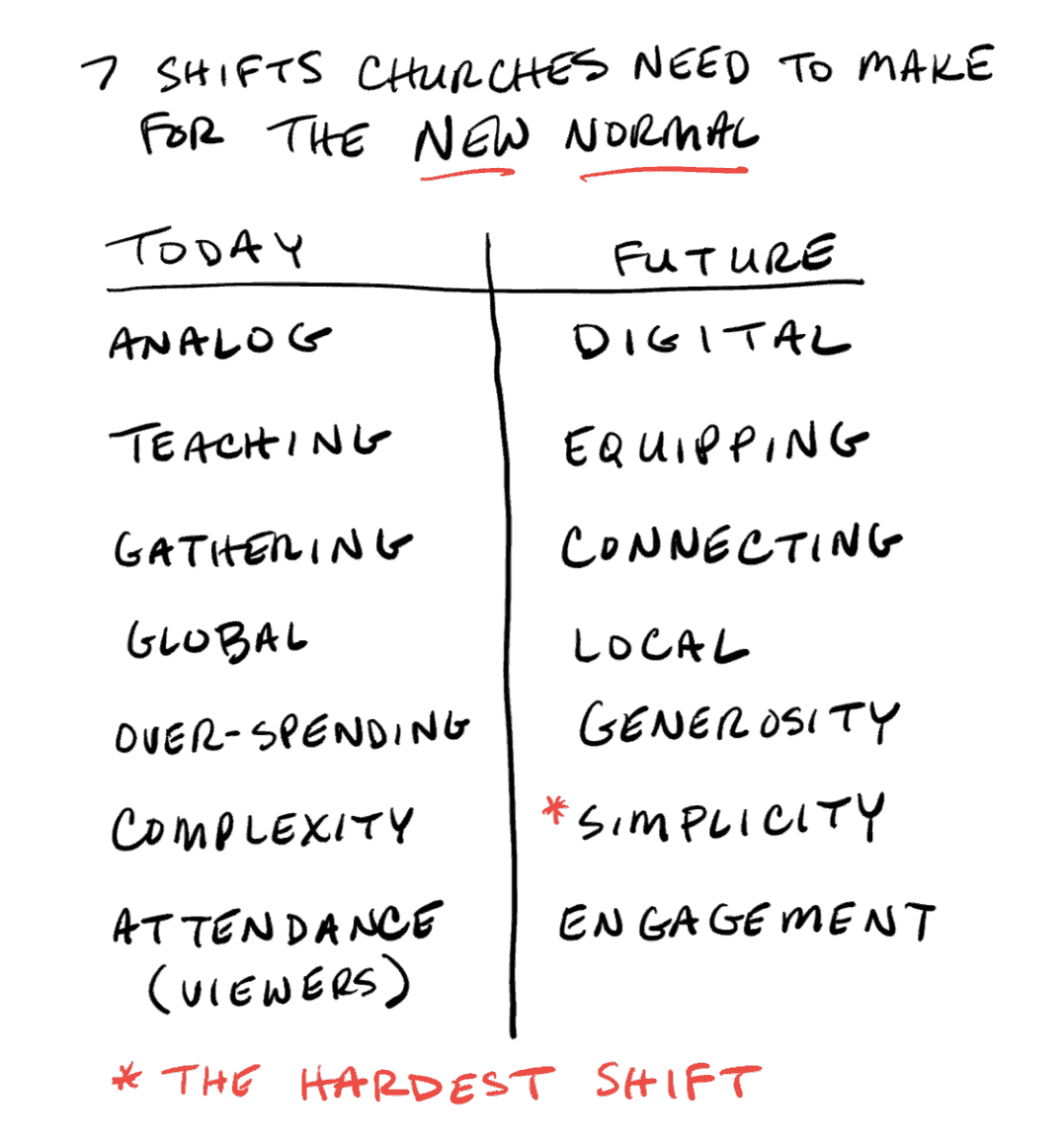How must the church change for a new normal?
I’m noticing two types of church leaders right now. One type of church leader is just waiting for things to go back to normal so that we can get back to doing church the way we’ve always done church. The question they’re asking me is this:
“When do you think we’ll be able to reopen our churches for normal services?”
I don’t know the answer to that question, but I’m confident it’s probably longer than you think.
Preparing for the Long Haul
Since weeks into the shut down I’ve heard the same waves of false of hope that we’ll be back to normal soon. But most of us will not be returning to large social gatherings, including church services, until widespread testing and vaccines are available. That continues to be a question mark.
Between now and then, there may be some loosening of guidelines where large social gatherings are allowed. But as cases return and increase again (because widespread testing and vaccines are not available), the guidelines will tighten again.
Even when they do loosen, the majority of people, especially older people and those in the high-risk categories, will not immediately return to our church gatherings. After all, health experts have been warning us for months now that the best thing we can do to protect ourselves and protect others is to stay at home if at all possible.
You probably will stop reading my content after this next statement. I hope I’m wrong, but I think church leaders need to be planning for a full year before large social gatherings are happening throughout the entire country without restrictions. Are you prepared for that?
And that brings me to the second type of church leader I’m starting to encounter.
They aren’t so concerned about when we might return to normal, because they realize what we’ve experienced…and will continue to experience for many months…is going to force the church to change. “Normal” isn’t coming back. The question they’re instead asking is this:
“How must the church change for a new normal?”
And they’re ready to start making those changes now. They’re not waiting for their church doors to reopen.
Since my book, The Unstuck Church, came out, I’ve been talking a lot about interruptions. I mentioned that when churches get stuck, the natural pull is toward decline and death…unless there’s an interruption. In fact, I’ve been praying churches would experience an interruption. I’ve expressed it this way:
“Interruptions jolt us. They upset the equilibrium. They force a reaction. Interruptions challenge us to pause and assess what’s happening. Then build a plan to respond. And ultimately interruptions provoke us to act.”
When I started praying for an interruption, I just want you to know that I wasn’t praying for this interruption. Please don’t hold this against me. What people are experiencing is awful. The virus is awful. The death is awful. The isolation is awful. The impact on people’s financial well-being is awful.
On the other hand, I think this interruption is going to strengthen the church’s mission. It’s going to force churches to embrace a new normal. That will include shifting ministry strategy to spread the Gospel in a culture that was already changing well before the interruption (or in this case, disruption) that this virus caused.
So what does this new normal look like?
Let me highlight seven shifts that I foresee churches will need to make as a result of this crisis:

1. Shift from analog to digital.
This one is obvious. However, what may not be obvious is that digital is not going away after the virus is wiped out.
Digital is here to stay. And, churches need to shift to making this a primary platform for everything they do rather than just a stream of their Sunday services. That likely means you also need to shift your staffing structure to align with this new reality.
Digital is here to stay. Churches need to shift to making this a primary platform for everything they do rather than just a stream of their Sunday services. Click To Tweet2. Shift from teaching to equipping.
Teaching is important, but just about every environment and program churches have offered in the past was designed to teach people using one-way communication rather than equipping people with the tools and resources they needed to engage the Bible, practice spiritual disciplines and live out God’s mission for their lives.
We need to help people move from consuming teaching content to engaging a personal, spiritual journey to follow and become like Jesus.
We need to help people move from consuming teaching content to engaging a personal, spiritual journey to follow and become like Jesus. Click To Tweet3. Shift from gathering to connecting.
Even before this crisis, people had less and less time to gather at the church. Churches were not winning by adding more and more events to their calendars. Even more so after this crisis, people will understand the need for friendship and community. Solitary confinement and isolation is punishment. God designed us to need one another. Weeks and months of social distancing will make people more aware than ever that it’s not good to be alone.
4. Shift from global to local.
I’m just going to come right out and say it. Churches have been wasting way too much money sending people to Africa and Asia and other distant parts of the world on “missions” trips. We can continue sending financial resources to help local churches and ministry organizations in those countries, but God has our churches in our communities to reach our mission fields.
I think it’s been too easy to divert attention to global efforts in order to avoid the much harder challenge of how we need to engage our local “missions” efforts of reaching people outside the church and outside the faith.
5. Shift from over-spending to generosity.
This is especially the case with staffing expenses. We knew even before this crisis that declining churches have 35% more paid staff than growing churches. You read that correctly. Declining churches have more staff.
With declines in giving, this crisis is going to force churches to reduce expenditures for staff and facilities which, in the long run, should help churches free up resources to partner with local agencies and churches to address spiritual, physical and mental health needs in their communities.
6. Shift from complexity to simplicity.
We’re already hearing stories from churches that realized this crisis is making them simplify their ministry strategy. That’s a good thing because we’ve known from previous research that keeping people busy in church activities doesn’t help people become more like Jesus.
Complexity is one of the most obvious signs that a church has begun to experience decline on the church life cycle.
Complexity is one of the most obvious signs that a church has begun to experience decline on the church life cycle. Click To Tweet7. Shift from counting attendees (and now viewers) to engagement.
Again, this is a trend that we saw happening long before the coronavirus. However, my fear is that we’ll easily shift from thinking attendance was the win to thinking the number of people who view our online services is the win.
Making disciples of Jesus is the win. We want to connect people with the body of Christ so that they have a chance to hear and respond to the Gospel.
That means we need to quickly move beyond just counting how many people showed up online to engaging new “guests” and helping them take their next steps toward Christ.
Counting online attendance is not the win. Making disciples of Jesus is the win. Click To TweetThat’s a starting point for the conversations that I think churches need to be having beginning today. Not when the church reopens. If you wait until then, it’ll probably be too late. It will be too easy to go back to doing church the way we’ve always done church, and we will have missed the opportunity of capitalizing on what we’re learning through this interruption.
If you read through that list of changes and thought, “We would have to become a completely different church in order to make those shifts.” That’s my point.
Do you need help considering and implementing the types of changes I’ve outlined above?
We know what you’re up against. We’ve been talking to 100s of church leaders since the coronavirus began, helping them navigate the necessary ministry shifts to help their church thrive.
Need help figuring out what to prioritize NOW? Let’s talk.






